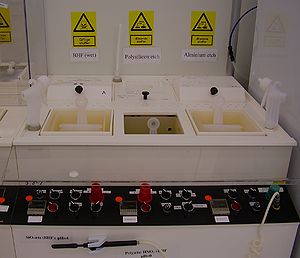Specific Process Knowledge/Etch/Wet Polysilicon Etch: Difference between revisions
No edit summary |
|||
| Line 1: | Line 1: | ||
'''Feedback to this page''': '''[mailto: | '''Feedback to this page''': '''[mailto:labadviser@danchip.dtu.dk?Subject=Feed%20back%20from%20page%20http://labadviser.danchip.dtu.dk/index.php/Specific_Process_Knowledge/Etch/Wet_Polysilicon_Etch click here]''' | ||
[[Category: Equipment|Etch Wet Polysilicon]] | |||
[[Category: Etch (Wet) bath|Polysilicon]] | |||
==Wet PolySi Etch== | ==Wet PolySi Etch== | ||
Revision as of 14:44, 25 August 2014
Feedback to this page: click here
Wet PolySi Etch

The wet PolySi Etch is an isotropic silicon etch. This holds for both a poly-silicon thin-film as well as single-crystalline material such as a Si(100) surface. The PolySi Etch process is placed in a dedicated PP-tank in a laminar-flow bench in cleanroom 4.
The PolySi Etch is typically used for opening holes in poly-silicon thin-films, using photoresist as an etch mask. Due to its isotropic nature the under-etching (etch-bias) at least amounts to the thickness of the poly-silicon layer. Another example of usage is etching of "circular-shaped" holes in silicon substrates.
The PolySi Etch is based on the combined oxidation of silicon followed by dissolution of the silicon oxide. The etch solution consists of:
HNO3 : BHF : H2O - (20 : 1 : 20)
NB: The life time of the solution is only a few days.
The user manual and contact information can be found in LabManager:
Isotropic Etch/Poly Etch info page in LabManager
PolySi Etch data
| PolySi Etch @ room temperature | |
|---|---|
| General description |
Etch of poly-si/Si(100) |
| Chemical solution | HNO3 : BHF : H2O (20 : 1 : 20) |
| Process temperature | Room temperature |
| Possible masking materials |
|
| Etch rate |
|
| Batch size |
1-25 wafers at a time |
| Size of substrate |
2-4" wafers |
